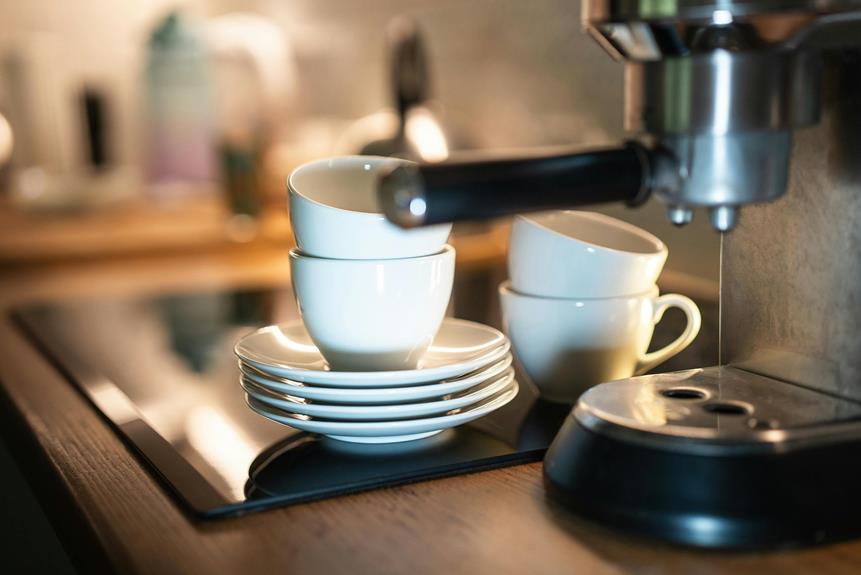
When your coffee maker flashes that 'Descale' message, it's trying to tell you something important about the inner workings of your beloved machine. But why does it say that, and how do you address it? The answer lies in understanding the impact of those stubborn mineral deposits and the simple steps you can take to keep your coffee maker humming along smoothly. So, before you think about your next cup of joe, let's uncover the mystery behind the 'Descale' alert and discover the fix that can make all the difference in your morning routine.
Understanding the 'Descale' Message
If your coffee maker displays the 'Descale' message, it means that the machine's internal components require cleaning due to mineral buildup. Over time, minerals from the water you use to brew your coffee can accumulate inside the coffee maker. These minerals, such as calcium and magnesium, form a residue that can affect the performance of your machine. When the 'Descale' message appears, it's essential to address it promptly to ensure your coffee maker continues to function optimally.
Ignoring the 'Descale' message can lead to issues like slower brewing times, strange noises during operation, or even complete machine failure. By descaling your coffee maker regularly, you can prevent these problems and extend the lifespan of your appliance. Descaling is a simple process that involves using a descaling solution or a mixture of water and vinegar to remove the mineral buildup. Following the manufacturer's instructions for descaling will help maintain the quality of your coffee and the performance of your machine.
Importance of Descaling Your Coffee Maker
Regular descaling of your coffee maker is crucial to maintaining its performance and longevity. Descaling helps remove mineral deposits that can build up over time from the water you use, such as calcium and limescale. These deposits can clog the internal components of your coffee maker, affecting its ability to brew properly and consistently. By descaling your coffee maker regularly, you can ensure that it continues to function efficiently, producing delicious coffee with optimal flavor.
Failure to descale your coffee maker can lead to various issues, including slower brewing times, weaker coffee, and even potential damage to the machine. Over time, the accumulation of mineral deposits can cause blockages in the water lines and heating elements, reducing the effectiveness of your coffee maker. This can result in a decrease in the quality of your coffee and may eventually lead to the need for repairs or a complete replacement of the machine. Therefore, making descaling a routine part of your coffee maker maintenance is essential for enjoying great-tasting coffee and prolonging the lifespan of your appliance.
Step-by-Step Guide to Descaling Your Coffee Maker
To effectively descale your coffee maker, begin by gathering the necessary descaling solution and water. First, ensure that your coffee maker is turned off and cool. Remove any remaining coffee grounds or filters from the machine. Then, mix the descaling solution with water according to the manufacturer's instructions. Pour this solution into the water reservoir of your coffee maker.
Next, start a brew cycle as if you were making coffee, but without adding any coffee grounds. Allow the solution to run through the machine and into the carafe. Once the cycle is complete, discard the solution in the carafe.
To rinse the coffee maker, fill the reservoir with fresh water and run a full brew cycle. Repeat this process with clean water a few times to ensure all the descaling solution is flushed out.
Tips for Preventing Future Descaling Issues
To ensure your coffee maker stays in top condition, remember to regularly clean and wipe down the machine's exterior surfaces. This simple step can prevent mineral buildup and grime from affecting the internal components of your coffee maker, reducing the likelihood of needing frequent descaling.
Additionally, use filtered water when brewing coffee to minimize the accumulation of mineral deposits in the machine. Hard water contains minerals that can build up over time and lead to the need for descaling more often. By using filtered water, you can prolong the time between descaling sessions and keep your coffee maker running smoothly.
Another tip to prevent future descaling issues is to follow a regular cleaning schedule for your coffee maker. This includes cleaning the carafe, filter basket, and any removable parts after each use. Regular cleaning can prevent coffee residue and oils from building up and causing clogs or affecting the taste of your coffee.




